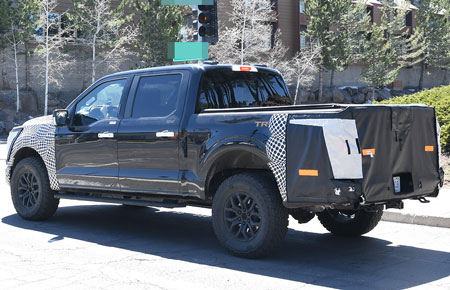By SEMA President and CEO Mike Spagnola
[Editor's Note: This column originally appeared in the Washington Examiner.]
The U.S. Environmental Protection Agency (EPA) released a proposal last month for strict new federal  multipollutant emissions standards for light- and medium-duty vehicles. The proposal would decisively tilt the U.S. car and truck market toward electric vehicles (EVs) over the next decade. The new standards would initiate for the '27 model year and gradually increase through the '32 model year.
multipollutant emissions standards for light- and medium-duty vehicles. The proposal would decisively tilt the U.S. car and truck market toward electric vehicles (EVs) over the next decade. The new standards would initiate for the '27 model year and gradually increase through the '32 model year.
If the EPA drafts standards are implemented by 2032 as proposed, the agency anticipates that two-thirds of all new-car sales in the United States would be EVs. This large-scale shift would significantly disrupt automotive industry supply chains and potentially eliminate large numbers of jobs in vehicle manufacturing, parts production and repair shops. Ford alone estimates a 30% labor reduction in its transition to EVs.
Likewise, much of the automotive specialty-equipment market--the parts and modifications you make to your vehicle once it leaves the car lot--is built around the internal combustion engine. The $51 billion aftermarket industry supports more than one million jobs in U.S. automotive manufacturing. The automotive specialty-equipment market has also led the way in alternative fuel innovations such as hydrogen, replacing older engine technologies with newer, cleaner versions, and even conversions of older internal combustion engine-based cars to new electric, hydrogen and other alternative fuels. Yet none of that is considered part of the broader plan to reduce greenhouse gases and criteria pollutants from automobiles.
Small businesses would be the most vulnerable to the disruptions caused by a seismic shift to battery-electric vehicles. According to the most recent Census Bureau tally of the almost 1,200 auto engine and transmission parts suppliers in the United States, more than 60% had 20 or fewer employees. These companies often make specialized components, operate on tight margins and rely on long-term contracts. They employ American workers with technical skills and create the often politically celebrated blue-collar jobs.
Large automakers are losing billions a year in their EV programs, despite the massive financial infusion of taxpayer dollars they are receiving from the government and subsidies to purchase EVs. If they are struggling, how are small businesses expected to survive?
Clean air and the reduction of greenhouse gases are goals everyone can acknowledge. That said, when governments arbitrarily pick technology winners and losers, the marketplace is deprived of choices and the public suffers. Instead of forcing this transition, the EPA should put in place incentives to support a diversified zero-emissions approach that takes advantage of breakthrough technologies across the spectrum.
Hydrogen, for example, is already being used as a power source in buildings, cars, trucks, forklifts, ships and trains. Hydrogen-powered cars have greater range and faster refueling times compared to EVs and reduce the need for limited-supply materials used in EV battery packs. And clean hydrogen generation is already feasible: The National Renewable Energy Laboratory website identifies five different methods to produce hydrogen economically from sustainable resources.
Other renewable fuels--including synthetic eFuels that allow legacy vehicles to operate in a carbon-neutral manner--should also be part of the equation. Where are the government-backed financial incentives for these alternate technologies?
The market is rightly skeptical of new EV technology, and right now, it simply does not have the infrastructure ready to support EVs. Yet by using multipollutant emissions regulations to force-feed EVs to the market, the government is effectively putting all its eggs into one technology basket.
The Biden administration should realize that the market's hesitation to adopt EV technology in the first place proves that putting the government's thumb on the scale is not an effective means of persuasion. But instead of adjusting course to let the market forge the transition, the administration is effectively doubling down on a flailing policy.
Meanwhile, a dozen states have recently introduced or passed legislation or resolutions affirming support for the internal combustion engine and for the government to remain technology-neutral in the debate to reduce automotive emissions. In Virginia, for example, it was only the state's slim Democratic Senate majority that stymied Governor Glenn Youngkin's campaign platform issue to repeal Virginia's internal combustion engine ban.
The EPA's emissions proposal is misguided and counterproductive. Instead of trying to force a clean energy transition, the Biden administration should support the work of innovators and protect the small-business owners and those they employ by letting the market and innovation drive solutions to the environmental challenges we all seek to solve.
For more information, visit sema.org/EPA-Proposed-Greenhouse-Gas-Rules.

 (
( Callout, which will take place on Saturday, May 20, as part of the NHRA's return to Chicago at the Gerber Collision & Glass Route 66 NHRA Nationals presented by Peak Performance at Route 66 Raceway.
Callout, which will take place on Saturday, May 20, as part of the NHRA's return to Chicago at the Gerber Collision & Glass Route 66 NHRA Nationals presented by Peak Performance at Route 66 Raceway. multipollutant emissions standards for light- and medium-duty vehicles. The proposal would decisively tilt the U.S. car and truck market toward electric vehicles (EVs) over the next decade. The new standards would initiate for the '27 model year and gradually increase through the '32 model year.
multipollutant emissions standards for light- and medium-duty vehicles. The proposal would decisively tilt the U.S. car and truck market toward electric vehicles (EVs) over the next decade. The new standards would initiate for the '27 model year and gradually increase through the '32 model year. 

 by booth--and you can see it all come together at
by booth--and you can see it all come together at 